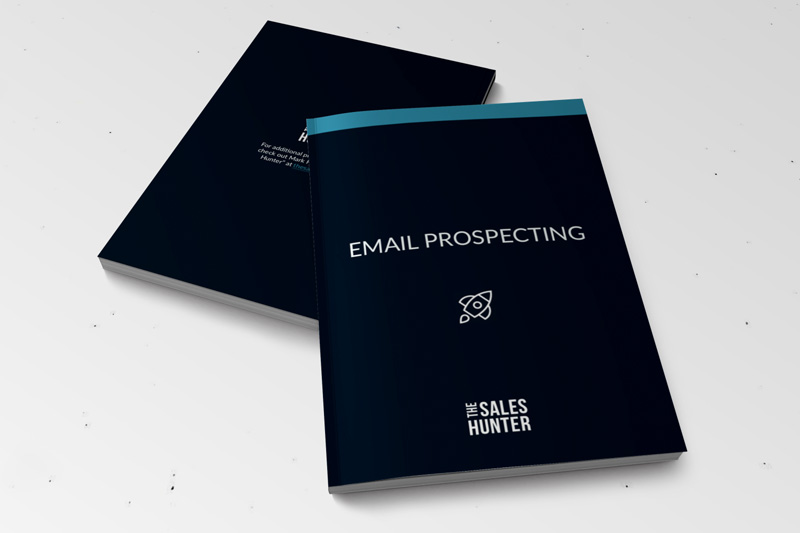How do you use email effectively to prospect?
Everybody uses email to prospect because it’s so easy, but let’s talk about how to use email effectively to prospect.
I am going to share 10 tips with you that you can be doing right now.
I put out new videos and sales tips like this every week, so be sure to hit subscribe my YouTube channel or subscribe to my blog to get these sent straight to your inbox every Wednesday morning.
For more insights on using email more effectively – saving you time and increasing your sales – pick up two of my books, A Mind for Sales and High-Profit Prospecting.
Video – How to Effectively Prospect with Email
1. Use Other Methods
Too many salespeople rely 100% on email to do all their prospecting. It is no wonder they are struggling and not successful! All they wind up doing is sending out more and more emails, but it does not work.
Email works when you combine it with the telephone and other tools.
For tips on how to prospect using the telephone, check out this blog post.
2. Stop the Spam
I’m going to let you in on a little secret: When you hit me with an email three or four times and I do not respond, my spam filter is probably going to pick it up and send it straight to junk.
The vast majority of prospecting emails wind up going to junk.
When I send out a prospecting email, I am doing it one-to-one. I am sending one email to one person and more than likely, that is going to get through.
Yet again, if I send it four or five times, spam filters are still going to pick it up, and my prospect will never hear from me again. You have to create value with the email.
3. Short
A good prospecting email is not one that gives you so much information that you can make a decision.
The purpose of your prospecting email is to gain interest in order to prepare them to have a conversation with you.
A short email is no more than four to six sentences, or two to three paragraphs. That’s it; it’s very simple.
Do not sit there and include 18 links and five pictures and so on. Make it singularly focused on an issue that is relevant to them.
4. Subject Line
The subject line is absolutely key.
The most valuable real estate is the subject line.
If they are getting your email on a smartphone, what are they seeing? They are seeing the subject line and the first six or seven words of the email.
If those first six or seven words are just you introducing yourself, that is a total waste. They will know right away it is a sales pitch.
The subject line and the first few words of the email need to complement each other. These two pieces need to be focused on something of critical interest and value to the prospect.
If you can make it timely in terms of making it time sensitive, you score even more points. Your prospect will think, “This is of interest to me and it’s urgent.”
5. Clear CTA
You have to have a clear call-to-action. A clear call-to-action is saying, “Call me and let’s discuss.”
I love saying, “Call me and let’s discuss,” and here’s why: They know they can hit reply and send an email back; that’s easy. They know they can just head to my website, but I want to have a conversation.
The conversation is the magic piece.
My go-to CTA is, “Call me and I can share more information with you,” or “I’d love to get your opinion on this.” It is very clear and very precise.
Do not sit there and use this as your CTA: “I will plan to call you tomorrow.” You are going to plan to call them tomorrow anyway!
You do not say, “I am going to send this email,” or “I am going to plan to call you tomorrow.” If there was any glimmer of hope they would call you back, they are simply not going to.
If you know you are going to call them the next day, do not tell them you are going to, just do it.
6. Control Links
I get more and more emails nowadays that have anywhere from two to seven links in there. What a waste.
All you are doing is overwhelming the prospect and making them think, “I don’t want to look at this; there is too much stuff in here.”
When I talk about controlling links, making it short and having a prospecting video, it is all about making your email viewable with just one swipe.
Prospects should be able to view your email on their smartphone with just one swipe.
That means you do not have 10,000 links. Depending on who you are sending it to and how strict their spam filters are, your links may very well send your email straight to the spam folder.
If you are sending it to a senior-level person, they are not going to open your links because they do not want to risk malware or anything of the sort.
Save the links for later on.

7. Use of Video
The use of video in emails is very popular right now. Use it but use it wisely.
Do not think just because you like getting video messages that other people like it.
Video message is just one deviation, or one additional tool in an email. For some people, it increases the view rate and the response. For others, it does not. It is something you have to step your way into.
Do not let your video exceed 15 to 20 seconds.
People send me video messages that are two or three minutes long; I do not have time to watch that long of a video. Forget it. Delete. I am going to watch your first 10 seconds and kill it.
When you send out a two- to three-minute prospecting video, what are you telling the prospect? “I don’t value your time.”
On the other hand, when you send out a 10 or 15 second video, what does it tell the prospect? It tells them you respect their time, and they may be more interested in having a conversation with you.
8. Bring Value
Every prospecting message must bring value.
The prospecting message that says, “Hey, you haven’t responded to my messages,” is stupid. Sending a message that says, “I sent you something a week ago; clearly, you have been busy and have not taken a look,” is also dumb.
Every message you send out needs to bring new value.
We are in the era where it is no longer ABC, or always be closing. It is now ABV, or always bring value.
Every message must have a new key point of interest that is going to capture them.
For my latest top 10 list of prospecting tips, check out this blog post.
9. Work Your Plan
Working your plan means that if you have a 20-step cadence, you are going to follow through on all 20 steps.
I do not sit there and just make two or three phone calls and think, “That didn’t work. They must not be interested.”
When I send a couple of emails to somebody and call them a few times with no response, I cannot say, “They are not interested.”
I have not had a conversation with them yet. How could I know if they are not interested?
The problem could be that I am simply not intriguing them enough right now. Work your plan all the way through.
10. Play the Long Game
You have to be prepared in using email to play the long game. The long game consists of continually tweaking your emails.
You are never going to have one email so great that you use the same one five years from now. No, playing the long game – like in any sporting event – means you are continually adapting and tweaking, not throwing the baby out with the bath water.
Playing the long game means you do not give up. If you have a valid prospect and go through your cadence yet receive no response, that does not mean you never come back to the prospect again.
Put the prospect aside for three to six months and go through that process again once you have made the necessary tweaks.
If that does not work, you are going to wait again and repeat. Continuously play the long game and you will eventually have them as a customer.
Now, let’s put this into action: I want you to check out my online university. One of the key things I offer are open office hours where you get to have one-on-one time with me.
My office is open, I send you a link and you simply jump on and talk with me, asking any questions you want. It’s a great tool and people are loving it!
I sure hope you have subscribed to my blog and channel, so you never miss a post and video like this every week. Keep learning with my books, A Mind for Sales and High-Profit Prospecting, too.
Great selling!
Copyright 2021, Mark Hunter “The Sales Hunter” Sales Motivation Blog. Mark Hunter is the author of A Mind for Sales and High-Profit Prospecting: Powerful Strategies to Find the Best Leads and Drive Breakthrough Sales Results.
linkedinyoutubetwitterfacebookinstagrampinterest













